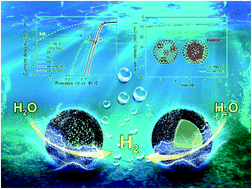Hollow carbon shells enhanced by confined ruthenium as cost-efficient and superior catalysts for the alkaline hydrogen evolution reaction†
Abstract
Alkaline electrochemical water splitting is expected to realize large-scale hydrogen production. High-cost platinum (Pt) has an intrinsically high activity as an electrocatalyst for the hydrogen evolution reaction (HER) due to its unique properties. However, there is a pressing need for developing inexpensive alternatives to high-cost Pt-based catalysts for large-scale H2 production, such as carbon-based catalysts. In this work, we report the use of hollow carbon sphere catalysts activated by ruthenium (Ru) structures encapsulated in the cavity. Hollow carbon sphere-confined Ru nanoparticles (HCRNs) and hollow carbon sphere-confined Ru layers (HCRLs) exhibit excellent catalytic performance for the alkaline HER. The HCRNs (Ru: 4.8 wt%) and HCRLs (Ru: 23.5 wt%) display high turnover frequencies (TOFs) of 0.77 s−1 and 0.25 s−1 at 15 mV, respectively, and small overpotentials of 33 and 18 mV at 10 mA cm−2 (η10), respectively. These catalysts also display a remarkable stability for 10 000 cycles, outperforming other Ru/C catalysts as well as commercial Pt/C catalysts (20 wt%, TOF = 0.19 s−1 at 15 mV, η10 = 38 mV). Density functional theory calculations reveal that the carbon shells are activated by electron transfer from the encapsulated Ru. These unique nanostructures enhance the carbon atoms-adsorbed hydrogen atom bond and lower the ΔGH* on the carbon surface via electron transport between their contact interfaces.



 Please wait while we load your content...
Please wait while we load your content...